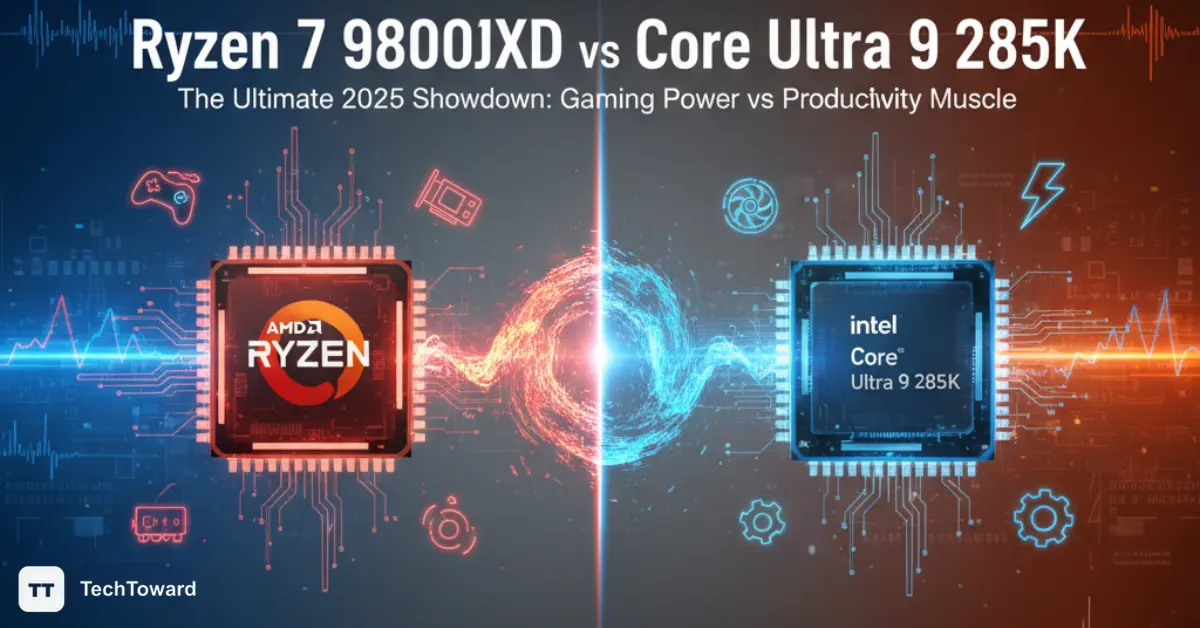In the battle for 2025 CPU supremacy, Ryzen 7 9800X3D often takes the crown for gaming performance, while Core Ultra 9 285K flexes stronger in productivity and multi-thread tasks. The “winner” depends on your use case: gamers lean AMD, content creators lean Intel.
1. What Are These Chips — A Basic Primer
If you’re new to CPU specs, here’s a friendly breakdown.
- Ryzen 7 9800X3D is AMD’s gaming flagship in the Ryzen 9000 series, built on Zen 5 architecture with 3D V-Cache to boost gaming throughput.
- Core Ultra 9 285K is Intel’s Arrow Lake / Core Ultra entry into high-performance desktop computing. It uses a hybrid architecture of P-cores + E-cores and brings integrated AI and efficiency enhancements.
| Spec | Ryzen 7 9800X3D | Core Ultra 9 285K |
| Architecture | Zen 5 + 3D V-Cache | Hybrid (P + E cores) |
| Cores / Threads | 8 cores, 16 threads | 24 cores, 24 threads (8 P + 16 E) |
| Base / Boost Clocks | 4.7 GHz base, up to 5.2 GHz boost | P-core up to 5.5 / 5.7 GHz, E-core lower frequencies |
| Cache / Special Tech | ~96 MB L3 (including 3D V-Cache) | 36 MB Intel Smart Cache + hybrid core architecture |
| TDP / Power | 120 W TDP typical | 125 W base, up to 250 W turbo |
So, AMD trades raw core count for optimized cache and gaming responsiveness, while Intel leans into hybrid core scaling and efficiency.
2. Gaming Performance — Where the Action Is
Because most users care about frame rates, let’s dive into gaming.
2.1 Benchmarks & Real-World Performance
- Intel’s 285K makes strides in productivity, but often falls behind AMD’s X3D chips in many games.
- The 9800X3D is frequently called “devastating” for gaming workloads, claimed to be the fastest gaming CPU.
- In efficiency benchmarks, 285K shows improved power usage in tasks like compression, but AMD still often “dominates” in gaming charts.
- Intel’s spec sheet shows the 285K hitting up to 5.7 GHz turbo in bursts.
- AMD’s 9800X3D follows with 8 cores, boost to 5.2 GHz, large cache, and full DDR5 / PCIe support.
In practice, in many eSports titles and high-frame scenarios, AMD’s 3D V-Cache gives it a clear edge by reducing memory latency and improving frame consistency.
2.2 Gaming Use Cases & Which Chip Wins
- 1080p / 144 Hz and below: Here the CPU often matters more than the GPU. CPU-limited scenarios tend to favor AMD’s 9800X3D.
- 1440p / 4K with a strong GPU: Differences shrink, and the CPU has less impact. Still, 9800X3D often edges ahead in minimum FPS / 1% lows.
- Competitive / eSports titles: These favor lower latency and tighter frame pacing. AMD’s advantage is more pronounced here.
Conclusion on gaming: For nearly all gaming-focused users, Ryzen 7 9800X3D is the safer, higher-performing pick.
3. Productivity, Content Creation & Multi-Thread Workloads
If you use Adobe Creative Suite, Blender, encoding, software development, etc., your demands shift.
3.1 Multi-Thread Throughput & Efficiency
- In Cinebench and other multi-core tests, the 285K posts strong single- and multi-core scores, competitive with rivals.
- Intel’s hybrid architecture allows it to throw many efficient cores at background tasks while reserving its P-cores for heavier workloads.
- In compression/ decompression tasks (e.g. 7-Zip), the 285K shows strong efficiency metrics.
- Some reviewers say it “isn’t far behind” top-tier competitors in many productivity tasks and offers better performance-per-watt.
On the flip side:
- AMD’s architecture is still strong, and for workflows that are cache-sensitive or lightly threaded, the 9800X3D won’t lag too far behind.
- But in heavy, massively-threaded workflows (video encoding, compiling, rendering), Intel often scales better because of its higher effective core count.
Conclusion for productivity: Core Ultra 9 285K has the upper hand in multi-threaded workloads and content creation scenarios.
4. Power, Efficiency & Thermals
A processor’s performance isn’t just about raw numbers — how much power it uses and how hot it runs matter greatly.
- The 285K often shows ~29–40% efficiency gains over older comparable Intel chips in certain tests.
- It is often characterized as “way more efficient” than prior Gen Intel CPUs.
- In mixed use (gaming + background tasks), the 285K may draw 50–60 W less power compared to older i9 systems, with temperatures of ~60–65 °C under load.
- AMD’s 9800X3D, with 120 W TDP, is also relatively efficient, though under sustained heavy usage or overclocking it may draw more power than nominal.
On the thermal side, both chips demand good cooling — either high-end air coolers or quality AIO liquid solutions. The 9800X3D can push the thermal envelope under extreme or sustained load.
Takeaway: Intel’s 285K is more power efficient, especially under mixed or sustained loads. AMD is still competitive, but with less margin.
5. Platform, Compatibility & Future Upgrades
You also need to factor in what else you’ll pay: motherboard, future upgrades, ecosystem support, etc.
5.1 Socket & Platform Costs
- Ryzen 7 9800X3D uses AM5, with a mature ecosystem and many DDR5 / PCIe 5.0 boards, and a good upgrade path.
- Core Ultra 9 285K uses a new Intel socket (e.g. LGA 1851 / Arrow Lake), so older Intel motherboards are incompatible. You’ll need a brand new board.
5.2 Future-Proofing
- AMD’s AM5 platform has been promised long-term support and is more familiar to the market.
- Intel’s new platform is a reset; whether Intel supports it well long-term is still something the industry is watching.
5.3 BIOS, Drivers, Ecosystem Maturity
- Because Intel’s Core Ultra / Arrow Lake is newer, BIOS stability, firmware updates, driver maturity, and platform robustness may see growing pains.
- AMD’s ecosystem is more mature, though early users of the 9800X3D have occasionally reported BIOS/motherboard quirks.
6. Which One Should You Choose? (Step-by-Step Decision Guide)
Here’s how you can methodically pick between them:
- Define your main use case
- If you game 80%+ and want top FPS and low latency → lean AMD.
- If you do video editing, rendering, development, virtual machines → lean Intel.
- Check platform & budget constraints
- Are you okay buying a new motherboard? Intel forces a platform shift.
- Is DDR5 cost or availability a concern?
- Power & thermal envelope
- If you need low noise, low power draw, or have strict thermal limits → Intel 285K is strong.
- If you have robust cooling and less concern over energy usage → AMD offers headroom.
- Long-term upgrade path
- AMD’s AM5 is a known, stable ecosystem.
- Intel’s new platform is promising but less proven in long-term support.
- Weigh gaming vs marginal multi-thread gains
- If real-world gaming performance is your priority → AMD wins more often.
- If you’re chasing small gains in productivity benchmarks → Intel might edge ahead in certain workloads.
7. Real-Life Anecdotes & Industry Voices
- Some users on community forums report stable performance with the 285K, saying “performance is admirable.”
- Expert reviews praise the 285K’s improved efficiency and power characteristics compared to previous Intel generations.
- AMD claimed big performance deltas versus Intel in early marketing for the 9800X3D, especially in gaming.
- Conversely, early AMD 9800X3D users flagged motherboard or BIOS compatibility issues with certain board revisions, remedied by BIOS updates.
These anecdotes underline that both chips are powerful, but real-world factors like compatibility, BIOS maturity, and cooling quality matter a lot.
FAQs
Q: Which is better for 2025 gaming, Ryzen 7 9800X3D or Core Ultra 9 285K?
A: Ryzen 7 9800X3D is generally better for gaming across most titles, especially in CPU-bound scenarios, thanks to its 3D V-Cache and lower latency.
Q: Is Core Ultra 9 285K better at productivity tasks?
A: Yes — especially for multi-threaded workloads like rendering, encoding, compiling, where Intel’s greater effective core use shines.
Q: Which chip uses less power?
A: Intel 285K is typically more power efficient under mixed or sustained loads, leading to lower overall consumption and thermals.
Q: Do I need a new motherboard for Intel 285K?
A: Yes — you’ll need a chipset compatible with Intel’s new socket and architecture.
Q: Are there stability issues with Ryzen 7 9800X3D?
A: Some early users did report BIOS or memory compatibility problems, but updating motherboard firmware often solves them.
Final Verdict
In the 2025 processor war, there’s no one-size-fits-all champion. Here’s how to lean:
- For gaming-first builds where maximizing frame rates and minimizing latency is crucial, Ryzen 7 9800X3D is often the safer bet.
- For productivity, content creation, rendering, or heavy multi-thread workflows, Core Ultra 9 285K tends to have the edge in throughput and efficiency.
Considering platform maturity, upgrade path, and ecosystem, AMD’s solution is more tried-and-true today.


